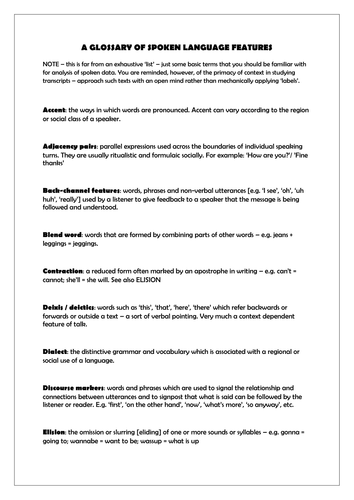
This is a glossary of terms / features of spoken language. This is far from an exhaustive ‘list’ – just some basic terms that you should be familiar with for analysis of spoken language data. It's organised in alphabetical order. It can be used as a guide for students to annotate and identify features in spoken language date.
Example of resource:
Accent: the ways in which words are pronounced. Accent can vary according to the region or social class of a speaker.
Adjacency pairs: parallel expressions used across the boundaries of individual speaking turns. They are usually ritualistic and formulaic socially. For example: ‘How are you?’/ ’Fine thanks’
Back-channel features: words, phrases and non-verbal utterances [e.g. ‘I see’, ‘oh’, ‘uh huh’, ‘really’] used by a listener to give feedback to a speaker that the message is being followed and understood.
Blend word: words that are formed by combining parts of other words – e.g. jeans + leggings = jeggings.
Example of resource:
Accent: the ways in which words are pronounced. Accent can vary according to the region or social class of a speaker.
Adjacency pairs: parallel expressions used across the boundaries of individual speaking turns. They are usually ritualistic and formulaic socially. For example: ‘How are you?’/ ’Fine thanks’
Back-channel features: words, phrases and non-verbal utterances [e.g. ‘I see’, ‘oh’, ‘uh huh’, ‘really’] used by a listener to give feedback to a speaker that the message is being followed and understood.
Blend word: words that are formed by combining parts of other words – e.g. jeans + leggings = jeggings.
Something went wrong, please try again later.
This resource hasn't been reviewed yet
To ensure quality for our reviews, only customers who have purchased this resource can review it
Report this resourceto let us know if it violates our terms and conditions.
Our customer service team will review your report and will be in touch.
£2.00
